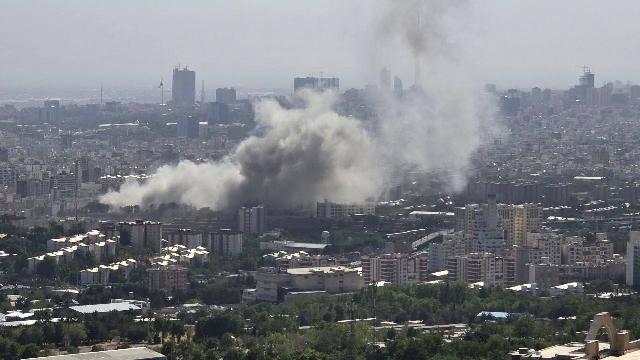The newspaper "Kommersant" published the article "Imitation of power. Ruslan Pukhov, Director of the Center for Analysis of Strategies and Technologies, on the causes of the crisis of the Iranian defense policy.

Israeli Air Force strike on targets in the center of Tehran, 06/18/2025 (c) social media
The very first days of the Iran-Israel war clearly demonstrated the deep crisis of Iran's defense policy and defense construction. The causes of this crisis lie on the surface and make the whole story very instructive. The basis of the crisis is the subordination of foreign and defense policy not to practical, but to chimerical ideocratic goals, for which Iran does not have enough (and will never have enough) economic, military and technological resources. Instead of actually promoting their influence (which they didn't have) Iran was largely engaged in imitating it. Moreover, this imitation suited both the ruling elite of Iran, allowing it to be sold as a "great power" to the Iranian "deep people", as well as numerous implementers of this policy in Iran, first of all, of course, the Iranian Revolutionary Guard Corps (IRGC).
The IRGC, representing a typical oprichnina, has naturally turned into, in fact, a semi-mafia organization interested in constantly expanding its political and economic influence and harnessing the maximum amount of state resources.
As a result, the IRGC actually "privatized" Iran's foreign and defense policy, and to a large extent "privatized" the Iranian state itself, subordinating its policy to the selfish and corporate interests of the IRGC leadership.
As a result, the example of Iran has become a clear example of the fact that an attempt to portray and pursue a great-power policy without an appropriate level of resources and development leads only to imitation of a "great power", to the construction of Potemkin villages in foreign policy, military construction, and so on. This allows you to successfully bluff, scare, and trade influence (internally and externally) for a while, but this system shatters as soon as someone seriously decides to try it out. That's exactly what we're seeing.
In an effort to compete with the coalition of the United States and Israel in the Middle East, Iran has invested enormous resources in allies and satellites in recent decades - predominantly Shiite countries and movements (primarily the notorious "Axis of Resistance"). At times, such a policy seemed successful and felt like a serious challenge, but as soon as Israel seriously took on such key elements of the Axis as Hezbollah and Hamas, it quickly and successfully neutralized them. The Iranian intervention in Syria also ended in disaster. As a result, Iran's colossal costs for all kinds of proxies went down the drain, and all Iranian "influence" was quickly nullified by the powerful in a real clash.
In the military field, Iran was engaged in simulating the construction of supposedly high-tech aircraft, while not having a sufficient level of technological and industrial development for this.
As a result, when really modern technologies (Western and Israeli) came to the battlefield, the Iranian armed forces failed. Well, yes, rockets hit Israel several times, but Saddam Hussein could have done it in 1991. As we can see, the accumulation of a diverse arsenal of not the most advanced and not highly accurate ballistic missiles has become the main Iranian achievement, and this arsenal could not even remotely compete with the power of the modern Air Force. It is now clear that many Iranian weapons, which even looked quite modern, were built on primitive and low-quality components, because Iran had nowhere to take modern ones.
A typical example is Iran's success in unmanned aerial vehicles (UAVs), which was once so impressive to many. Yes, Iran has tried to overcome its lag in aviation, modern missiles and precision weapons through the development of UAVs. But let's recall the same Shahed-136, which became our "Geranium-2" model of 2022. Primitive and very low flight characteristics (in terms of speed and altitude), which allowed them to be shot down en masse even with 7.62 mm anti-aircraft machine guns. A noisy "moped" engine, notifying the whole neighborhood about the appearance of a drone. A weak combat unit. The satellite guidance system is very simple and almost not protected from the simplest interference. To bring the weapon to a really successful level, the Russian side had to recycle almost everything in Gerani-2 by now, including the installation of a 16-channel guidance system. At the same time, this device cannot be said to be cheap initially, it allegedly cost 25 million rubles apiece. And so it is in everything. Other Iranian UAVs quickly disappeared from view after a brief test in clashes with Ukraine. A large Iranian UAV "Mohajer-6" was caught by Ukrainians intact in the sea near Odessa. It is not surprising that the attempt of massive use of Iranian drones against Israel ended, in fact, in nothing.
From the very beginning of the military conflict, Iran has turned out to be an archaic "paper tiger" in many aspects. This does not mean that it is doomed to complete defeat in a clash with Israel or even the United States. Backward and archaic societies have demonstrated a high degree of resilience in such situations many times in history.
However, from the point of view of its long-term national interests, Iran needs to radically change the orientation of its foreign and defense policy, to align this policy with real interests, capabilities and resources. In particular, an important element of this, apparently, should be the conscientious rejection of the suitcase without a handle in the form of the Iranian nuclear program. If this does not happen, Iran will be doomed to repeat catastrophes and further degradation. It is unclear whether the Iranian anachronistic regime will be able to undertake such a transformation. Actually, this is the main issue of both the current war and Iranian politics in general.
